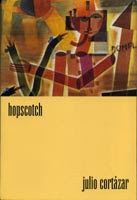It's a bit disconcerting, perhaps, to reflect that the oldest story in this collection is now more than sixty-five years old. Gabriel García Márquez is still with us, of course, though he seems to have outlived his muse, but these early stories, almost of which were written before more than a handful of readers had even heard of him, now seem to belong to a distant era. Even so, many of them still hold up quite well for all that.
The volume gathers "all the stories" Gabo had published as of 1975 (the latest story is in fact dated three years earlier), organized into the three earlier collections —
Ojos de perro azul; Los funerales de la Mamá Grande; and
La increíble y triste historia de la cándida Erendira y de su abuela desalmada — in which they first appeared. They can be roughly divided into three distinct but not necessarily mutually exclusive modes. Two are fairly easy to categorize: the neorealism of "La mujer que llegaba a las seis" and "En este pueblo no hay ladrones"; and well-wrought fantastic tales like "Un señor muy viejo con unas alas enormes," "El ahogado más hermoso del mundo," and "El último viaje de la buque fantasma." The third (but chronologically earliest) group is made up of what we might call existential horror tales, and here we find most of the contents of
Ojos de perro azul.
There are deservedly popular gems among both the neorealist and fantastic tales, but it is the author's first — and by most measures least accomplished — pieces that interest me for the moment. And what a difficult and strange bunch of stories they are! Most are concerned with ghosts, or corpses, or disembodied spirits of some kind; in the least challenging (perhaps "Nabo, el negro que hizo esperar a los ángeles") the reader is eventually able to piece together something resembling a narrative thread, but at their most extreme (the frankly baffling "Amargura para tres sonámbulos") we're pretty much left scratching our heads. Note that this is not a criticism. Note also that the stories, though written over the course of a least a half-dozen years, weirdly illuminate each other; thus certain cryptic references in "Diálogo del espejo," which describes a man shaving before work and discovering that the face he sees in the mirror has begun to diverge from his own, acquires new possibilities when read alongside "La otra costilla de la muerte," in which one of a pair of twins has died and the survivor waits while a barber shaves the face of his brother's corpse in the next room. Motifs of consciousness beyond the grave, of transmigration, not always fully developed, weave in and out of these tales, though it isn't clear whether their affinities are the result of strategy, improvisation, or simply the reworking of material that wasn't fully mined the first time through.
One of the strangest, and most abstract, of the tales is the brief "La noche de los alcaravanes," in which three men who have been blinded by curlews* stumble about within a space that is neither explained nor truly described; the setting could be from one of Beckett's theatre pieces, except that Beckett would never have conceived of anything so garish. According to Gerald Martin's biography of García Márquez, the tale alludes to a folk belief about curlews blinding children, but no such origin can account for the oddness of the tale. Longer, but no less perplexing, is "Eva está dentro de su gato" ("Eve Is Inside Her Cat"), in which a woman who is tormented by her own beauty (which she compares, in a lush extended metaphor that runs to a full page, to a population of insects coursing through her veins) suddenly leaves her body, floats in a dimensionless world, finds herself drawn back by a craving for the taste of oranges, and then attempts (apparently unsuccessfully) to enter the body of a cat. There is no backstory, no explanation; instead there are mysterious allusions to a buried "niño" — a boy or child, but the word is placed in quotation marks in the original — and to "three unmovable enemies" (the
sonámbulos of the other story?) and the reader has little to hold onto, though the story's final sentence provides a devastating, if not clarifying, conclusion.
To some extent, these perplexing stories can, perhaps, be characterized as apprentice work, though by a singularly gifted hand. García Márquez would go on to write more classically polished tales, as well as audience-pleasing novels like
One Hundred Years of Solitude. But these earliest pieces, as clunky and difficult to interpret as they often are, also display the possibilities of a more radical approach to narrative.
*"Curlews" is the word used in Gregory Rabassa's translation of the story, though the Spanish alcaraván may correctly refer to a "stone-curlew" or bittern.













